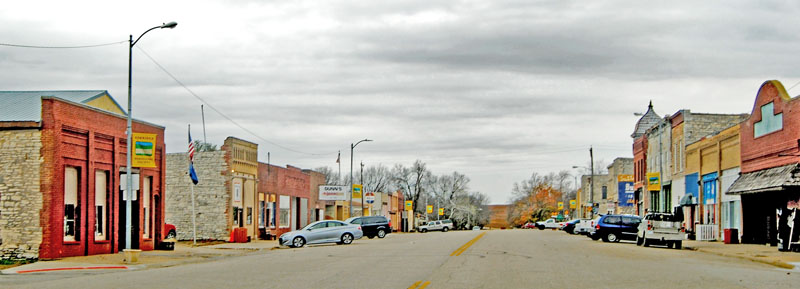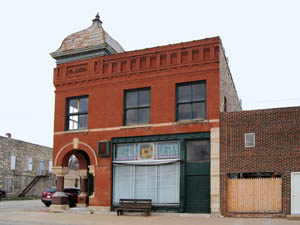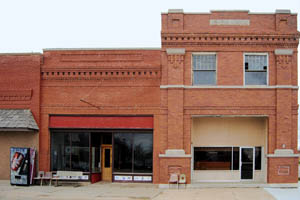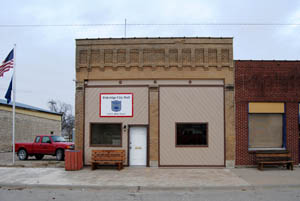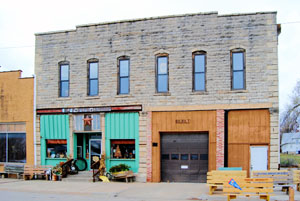Eskridge, Kansas, is an incorporated town in Wilmington Township of Wabaunsee County. As of the 2020 census, it had a population of 439 with a total area of 0.52 square miles, all land.
Colonel Ephraim H. Sanford purchased 460 acres, platted and laid out Eskridge in 1868 at “the Corners”, an intersection of Bronc Rider Road and Eight Mile Road, just about a mile east of the current downtown.
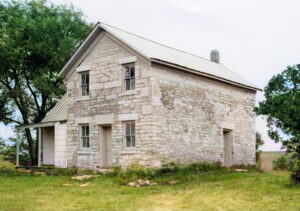
Colonel Ephraim H. Sanford’s house in Eskridge, Kansas, still stands today at 18140 Sanford Road.
Sanford, originally from New York, was an accomplished criminal attorney, a judge, a newspaper publisher, and a political activist who named the town Eskridge after a friend, C.V. Eskridge, the publisher of an Emporia newspaper, the Emporia Republican. Sanford purchased Eskridge’s paper and moved the equipment to his new town, starting a newspaper called the Landmark. He allowed Charles Eskridge to buy the first lot. Eskridge served in both houses of the legislature and was elected as lieutenant governor under Governor James M. Harvey in 1869.
Sanford moved to Kansas in 1857 to support the Free-State movement, became a colonel during the Civil War, and later served in the state legislature.
Sanford built a store, a tavern, and a stage station; published the Landmark newspaper; and practiced law.
A post office was established on October 18, 1869. Although a few people built houses and even had businesses, the town never flourished in its early years.
In 1871, Sanford nearly succeeded in moving the county seat from Alma to Eskridge, losing by only 19 votes. At the time, the entire town consisted of Sanford, his wife, and two daughters.
In 1880, the Atchison, Topeka & Santa Fe Railroad company selected a townsite that bordered Colonel Ephraim Sanford’s town along its west side. The railroad then surveyed, platted, and laid out lots. That year, the railroad stopped in Eskridge on its route from Burlingame to Manhattan. Dr. M.F. Trivet built the first house in June 1880. He later opened a drug store and began practicing his profession. H. Lawlor built the Lawlor House hotel, and Joseph Emerson erected the Santa Fe House.
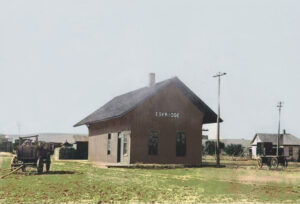
Manhattan, Alma & Burlingame Railway Depot in Eskridge, Kansas.
With the new depot and the proposed business district located a mile to the west, the old businesses moved their buildings to the new town’s Main Street. The town soon flourished, and its most significant growth came in the cattle business. While the expansive tallgrass pastures had provided great opportunities for the earliest settlers who had owned livestock, the ability to transport large numbers of cattle into Eskridge by rail made the cattle pasturing business explode. The Eskridge railhead became one of the leading shipping points for cattle in Kansas.
A schoolhouse was erected in 1881, and that fall, the first school was opened with Miss Emma Henderson as the first teacher and 124 students attending. In the same year, William Earl moved his store building and built the first new store.
By 1882, Eskridge had a population of about 450. At that time, the town had two drug stores, three dry goods stores, two hardware stores, a harness shop, two millinery establishments, a boot and shoe store, and two grocery stores. The place’s chief business is putting up and exporting baled hay, of which not less than 20,000 tons would be shipped this season. At an average of $3 per ton, this would bring a return of $60,000, a pretty good revenue for a small place. That year, W.W. Cone moved the first newspaper in the new town, the Home Weekly, from Alma. This was the second of the six newspapers Eskridge supported at different times.
By 1884, the town had grown considerably, and the surrounding country was being rapidly developed. In 1885, Eskridge was home to several farmers and stock raisers, two newspaper publishers, two hardware stores., two lumber dealers, a carpenter, a liveryman, two attorneys, a drug store, a general mercantile, a real estate company, a photographer, a manufacturer of woolen goods, and the Central House hotel.
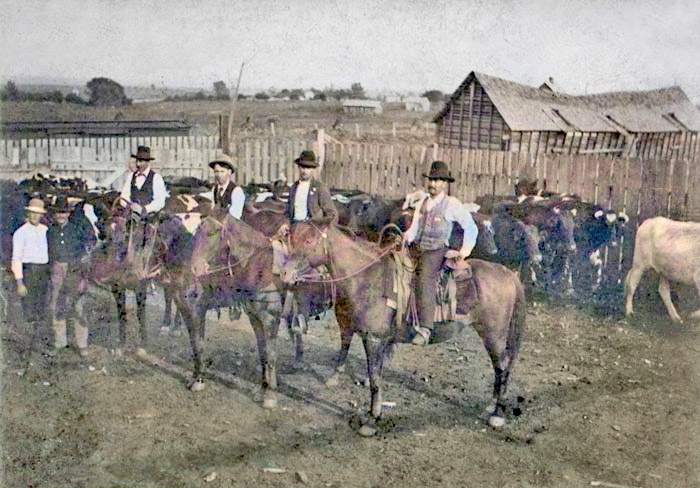
Eskridge, Kansas Stock Yard, 1880s.
In 1890, disaster struck Eskridge. All the west side of Main Street between Trusler’s and Mudge’s was burned. E.L. Shumate & Son, W.H. Mills, J.W. Taylor, and Parmiter & Son were the principal sharers in a $25,000 loss. The town quickly rebuilt, with virtually every shop that was destroyed replacing its loss with a new building.
At about this time, a new era of prosperity began as the hardships of pioneer life disappeared. By then, nearly every farmer had an orchard, and large barns were built to accommodate the produce. Fine new homes replaced the small houses.
In 1897, 183 train carloads of stock were shipped from the Eskridge depot.
In 1898, Wabaunsee County sent to market more cattle than any county in the state. In one three-week period, 33 carloads of cattle were shipped out of Eskridge.
Two banks were established in town, the Security State Bank and the Eskridge State Bank, each located on opposite ends of the 100 block of Main Street. At the turn of the 20th century, Eskridge supported over 30 businesses, including two dentists, three physicians, two druggists, two dry goods stores, two general merchandise stores, a hardware and machinery store, two hotels, two lawyers, two lumber yards, two newspapers, a meat market, livery stable, a restaurant, a photographer, and two stores, Trusler’s and Earl’s, that “sold everything.” At that time, the creamery could produce 14,000 pounds of butter in a week, the telephone directory listed over 100 numbers, and a movement grew to build an electric railway from Topeka to Council Grove through Eskridge.
By 1907, the business directory listed 50 businesses, including two under the heading “Sells Everything.” The mayor’s platform included “the interurban road, electric lights, and waterworks.”
In 1909, a disastrous fire occurred at 3:00 a.m., when a lamp exploded in the bakery, destroying five businesses in two hours and damaging several others. To save Trusslers Hardware, 200 men dumped four tons of salt and over 100 barrels of water on the fire. Throughout the night, 500 men and women emptied the contents of the burned buildings onto Main Street.
“…when daylight began to dawn, Main Street reminded one of Market Street in Dublin.”
— The Star
By 1910, Eskridge was still located on the Burliugame & Alma division of the Atchison, Topeka & Santa Fe Railroad and was the second-largest town in the county. It had two banks, an international money order post office with four rural routes, electric lights, a weekly newspaper called the Tribune-Star, express and telegraph service, graded schools, telephone connections, a large retail trade, hotels, the Kansas Wesleyan Bible School, churches of five different faiths, and was a shipping point of considerable importance. That year, its population peaked at 797.
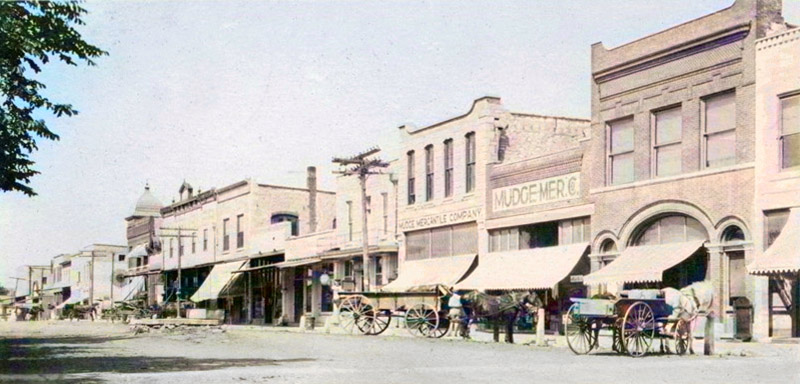
Eskridge, Kansas, about 1910.
By 1911, Eskridge had expanded to over 1,200 residents and 75 businesses, including five department stores, six produce houses, a photography gallery, and a piano store. The debt-free town operated its electric power plant. The town was both a center of commerce and a cultural center for the area. Eskridge led the effort to establish a superior high school system with college credits in the county. The Star, one of three local newspapers, boasted 1,800 subscriptions. A 500-seat, open-air “Air Dome” was one of two moving picture theaters. The Opera House continued to thrive, hosting European musicians. The settlers’ children, raised in a culture of ranching, education, and arts, made Eskridge proud.
On April 12, 1911, a tornado severely damaged half of the town, including two churches, and destroyed 25 homes. The Eskridge School was damaged beyond repair, leaving 20 to 30 students injured.
Then, in 1913, the unimaginable happened. Another fire on Main Street destroyed nine buildings on the west side of the 100 block, all located on the duplicate lots that had burned in 1890. Again, the Trusler building’s firewall stopped the fire’s advance, but all buildings to the north were lost. Once again, Eskridge rebuilt.

Eskridge, Kansas, after the 1913 Fire.
When the Great Depression began, Eskridge newspaperman Frank Frost proposed building a lake as a public works project. Citizens throughout the county petitioned for it. In 1933, barracks were built for 200 men to begin clearing a valley west of town. In 1936, the workforce doubled, and construction continued around the clock.
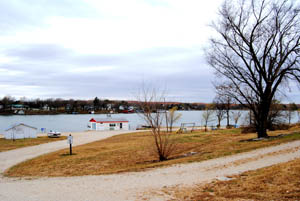
Lake Wabaunsee, Kansas by Kathy Alexander.
The City of Eskridge purchased the lake from the Lake Wabaunsee Corporation in 1937. By the end of spring 1938, Eskridge’s Lake Wabaunsee had filled.
During World War II, Lake Wabaunsee served as both a training ground for American soldiers and a prisoner of war camp for captured German soldiers. They worked as farm labor throughout the county during the summers of 1944 and 1945. Despite limited security, there were no escape attempts. Many prisoners maintained contact with their “employers” after the war.
Following the war, Eskridge’s population shrank to 500. However, the town still supported dozens of businesses, including a Harvard-trained doctor, three car dealerships, three grocery stores, a butcher, a blacksmith, and a drug store with a soda fountain and a pharmacy. Ranchers Ed Van Petten, Bob Widau, and Wendell Trantor organized the first Eskridge Labor Day Rodeo, a tradition that continues today.
In July 1960, the town saw a brief population jump when the U.S. Air Force designated a pasture northeast of Eskridge near Keene to house a 75-foot-tall Atlas rocket with a nuclear warhead that could be dropped with precision 6,000 miles away. Engineers, construction workers, and technicians lived in and around town during the construction. The project was completed in 1961, and the Atlas rocket lay in its “coffin-silo” for four years before it was decommissioned.
In the 1960s, the trains stopped running and were replaced by cattle trucks. As a result, more residents began commuting to Topeka to work and shop, and local businesses suffered.
By the 1970s, paved highways and the Interstate Highway system made commutes to Topeka, Manhattan, and Emporia commonplace.
Attractions within the city include the Maisie Community swimming pool, a Farmer’s Market held on the second Saturday of the month from May to August, and Labor Day weekend. Downtown Eskridge has two listings on the National Historic Registry, including a distinguished old bank building and the octagonal wooden bandstand at the park, which has a long history of social and community events.
Eskridge hosts several annual events, including the Eskridge Labor Day Rodeo, Veterans Day Parade, Fourth of July picnic in the park, a fireworks display at Lake Wabaunsee, and the Eskridge Fall Festival.
Lake Wabaunsee is located five miles west of Eskridge on Highway K-99 and K-4. It is one of only a handful in Kansas with cottages and year-round homes right on the lake shore. Attractions at Lake Wabaunsee include Wabaunsee Pines Golf Course, Lake Bum’s Bait Shop and swimming area, the Wild Olives Restaurant, and the July 4th fireworks.
Eskridge is located along the Native Stone Scenic Byway on Highway K-4, 16 miles southeast of Alma, the county seat.
©Kathy Alexander/Legends of Kansas, June 2025.
Also See:
Wabaunsee County Photo Gallery
Sources:
Blackmar, Frank W.; Kansas: A Cyclopedia of State History, Vol I; Standard Publishing Company, Chicago, IL 1912.
City of Eskridge, Kansas
Cutler, William G; History of Kansas; A. T. Andreas, Chicago, IL, 1883
New Prairie Press
Travel Kansas
Wabaunsee County Directory, 1885
Wabaunsee County Historical Society & Museum
Wikipedia

